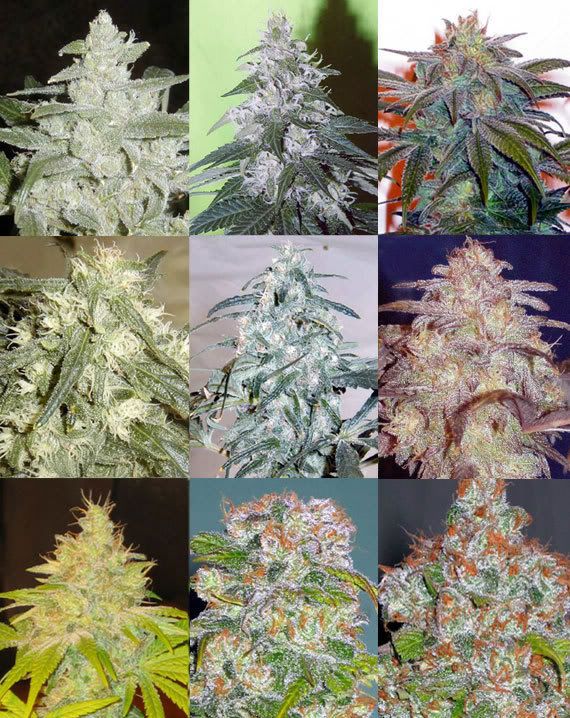 Light
Light Proper quality and quantity of light is vital for the powerful growth of Cannabis Seeds. Light must be made of wavelengths obligatory both for photosynthesis and for the induction or inhibition of ripening. Duration of light must also be correct to allow a vegetative and floral phase in the life cycle. Cannabis Seeds usually grow in a temperate climate from the time of the last frost in the spring till the mid-autumn. As a result, the first phase of its life cycle is vegetative during days of increasing length, while the second phase is floral during days of decreasing length. If grown out of season, in autumn or winter, Cannabis Seeds will produce intersexual flowers and hermaphrodite individuals.
Temperature
A lot of the effect of temperature on Cannabis Seeds is connected with the transpiration rate of the plant. Cannabis Seeds has a high transpiration rate and in hot climates is extraordinarily at the mercy of writing. The expansion of glandular trichomes and secretion of resin during hot weather guards against desiccation of the tissues, lowering the transpiration rate thru the epidermal surfaces of the plant by lowering leaf temperature. Blow Seeds are well adapted to heat but is not particularly long suffering of low temperatures. It'll endure light frosts near nil degrees celcius (32 fahrenheit), but a tough frost or a light frost of any duration will nearly always result in death. Low temperatures repress photosynthesis and slow the rate of metabolism of plants; extended cool weather often stunts the growth of Cannabis Seeds.
Temperature differentials between air and soil apparently have an observable effect on the phenotype of Cannabis Seeds.
This emphasizes the importance of edaphic (soil) as well as air temperatures to the structural development of Cannabis Seeds and hints at how they interact in figuring out phenotype.
Moisture
Cannabis Seeds flourish in a well-drained soil with a sufficient supply of water; it attains massive size in an irrigated habitat but is stunted by aridity. Standing water is quite negative to Cannabis Seeds since the roots suffocate simply. Therefore, porous organic soil with high sand content and moderate slope appears most fitted for proper growth provided water is widely available.
Varying moisture conditions influence the structural development and morphology of Cannabis Seeds, depending on the water requirements of the plant at different phases in its life cycle.
Dispersal
Natural agents in the dispersal of Cannabis Seeds include water, wind and animals. Some cannabis seeds benefit in passing through an animal by a decrease in the germination time and by the nutritional content of the excrement containing the germinating seed. Most cannabis seeds do not make it through the bowel in doable condition, suffering from cracking and digestion. Report asserts that cannabis seeds have germinated in from 12 to twenty-one hours after passing thru the stomachs of numerous birds and observed in the stomach contents of the EU magpie.
Race
Cannabis seeds are considered a monotypic genus by some investigators who assume the anatomical change in cannabis seeds isn't a foundation for distinguishing numerous species of genus cannabis seeds, but rather, types of one species "cannabis sativa." The polymorphous types of cannabis seeds evolve from a balance between the phenotypic response of a population of cannabis seeds to biotic and abiotic factors in the habitat that surrounds it and, the genotypic reply based mostly on adaptation to its environment of origin. In some countries, the only differentiation between sorts of cannabis seeds is between 'wild" and "cultivated" types. Both produce fiber and resin, but since the plant is generally for drug taking, the "cultivated" types have a reasonably high tetrahydrocannabinol (THC) content.
Community
As a member of plant communities, Cannabis Seeds exert pressures on itself and on surrounding plant species. The major effect comes from its very high nutrient requirements: little of these nutrients are recycled to other species and it is said to strip the soil. It does provide shade and shelter for smaller plants. Many plants produce herbicides in their leaves, but isn't known whether terpenes produced by cannabis seeds are lethal to other plants and if this is used to competitive advantage. Insects frequently prefer other vegetation to Cannabis Seeds, most likely because of the unpalatability of the resins.
Cannabis Seeds exhibit great plasticity, flourishing nearly everywhere in the world and this plasticity could likely keep it a jump ahead of other plant species in the evolutionary scheme.